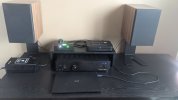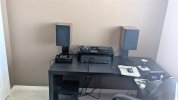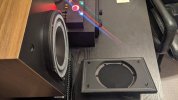This is a review, listening tests and measurements of the Vandersteen VLR coaxial bookshelf speaker. It is on kind loan from a member and costs US $1,815 a pair.
View attachment 216239
The VLR is quite dense and heavy. Construction seems nice other than bulging out driver. The cherry finish is to my liking as a woodworker:
View attachment 216240
Seemingly the design has not changed in decades given the screw terminals. The VLR like other Vandersteen speakers uses first order crossover to keep it "phase coherent." I got a kick out of this statement in the manual:
View attachment 216241
And this:
View attachment 216242
Measurements that you are about to see were performed using the Klippel Near-field Scanner (NFS). This is a robotic measurement system that analyzes the speaker all around and is able (using advanced mathematics and dual scan) to subtract room reflections (so where I measure it doesn't matter). It also measures the speaker at close distance ("near-field") which sharply reduces the impact of room noise. Both of these factors enable testing in ordinary rooms yet results that can be more accurate than an anechoic chamber. In a nutshell, the measurements show the actual sound coming out of the speaker independent of the room.
Likewise listening tests comply with the latest research into proper evaluation of speakers calling for mono, instead of stereo listening:
Reference axis was that of the tweeter.
Vandersteen VLR Measurements
As usual, we start with our frequency response graphs:
View attachment 216243
Oh boy! What the heck is going on here? We have rising chewed up high frequency response. Response is much smoother down low but sensitivity drops like a rock to just 80 dB. We have variation of 10 dB between that and the peaks in treble! Did they ever bother to measure this speaker? We also have large directivity error between 2 and 5 kHz.
Paradoxically, off-axis response looks good:
View attachment 216244
This results in predicted-in room response which again, is surprisingly better than on-axis:
View attachment 216245
Slope though is almost horizontal which means the speaker will sound bright. And with sensitivity of just 80 dB, will require tons of power.
There is essentially no directivity control:
View attachment 216246
View attachment 216247
So room sensitivity will be high. Due to coaxial design, vertical directivity is similar to horizontal:
View attachment 216248
Impedance dips very low at high frequencies:
View attachment 216249
Distortion is OK at 86 dBSPL but not at 96:
View attachment 216250
View attachment 216251
Waterfall shows resonances corresponding with those peaks in response:
View attachment 216252
And here is the step response:
View attachment 216253
Vandersteen VLR Listening Tests
I started listening without seeing the measurements. The first track was a duet of a male and female. I could barely hear the male while the female came right through! This theme continued with tracks segments with lower frequencies almost producing no volume Yet high pitch sounds would come through, albeit, a bit much. It is like someone constantly changing the volume control on you depending on the spectrum. And not a little, but a lot.
Conclusions
It is clear to me that the VLR is designed based on ideology and not any objective or proper listening tests. In both domains, performance ranges from OK to dismal and does so within the same piece of music! The brand must have strong carrying power to get people to buy flawed speakers like this. I rank the Vandersteen the second most broken speaker I have ever listened to or
The VLR Wood is designed to be placed up against the front wall, 15 degrees or more off-axis from the listening position, and used with the grills on. If you were having issues with the way they sounded why wouldn't you contact Richard Vandersteen and get some help with setup? He's very accessible and responds to emails within a day or two. You give the impression that your intention was to trash these speakers and use RV as your whipping boy from the get go. This review reflects very poorly on your set-up ability and integrity as a reviewer. Professional reviewers try to find the very best setup of the products under review, This review makes one question the credibility of all your reviews. I use VLR Wood speakers nearfield in a desktop system setup about 30 degrees off axis horizontally and 15 vertically from my ears. They sound balanced and dynamic with holographic imaging. If they sounded as you describe I'd surely get rid of them and RV would surely redesign them. This Ralph Nader of high end audio image you try to project just doesn't work at all for me. Your followers deserve better.This is a review, listening tests and measurements of the Vandersteen VLR coaxial bookshelf speaker. It is on kind loan from a member and costs US $1,815 a pair.
View attachment 216239
The VLR is quite dense and heavy. Construction seems nice other than bulging out driver. The cherry finish is to my liking as a woodworker:
View attachment 216240
Seemingly the design has not changed in decades given the screw terminals. The VLR like other Vandersteen speakers uses first order crossover to keep it "phase coherent." I got a kick out of this statement in the manual:
View attachment 216241
And this:
View attachment 216242
Measurements that you are about to see were performed using the Klippel Near-field Scanner (NFS). This is a robotic measurement system that analyzes the speaker all around and is able (using advanced mathematics and dual scan) to subtract room reflections (so where I measure it doesn't matter). It also measures the speaker at close distance ("near-field") which sharply reduces the impact of room noise. Both of these factors enable testing in ordinary rooms yet results that can be more accurate than an anechoic chamber. In a nutshell, the measurements show the actual sound coming out of the speaker independent of the room.
Likewise listening tests comply with the latest research into proper evaluation of speakers calling for mono, instead of stereo listening:
Reference axis was that of the tweeter.
Vandersteen VLR Measurements
As usual, we start with our frequency response graphs:
View attachment 216243
Oh boy! What the heck is going on here? We have rising chewed up high frequency response. Response is much smoother down low but sensitivity drops like a rock to just 80 dB. We have variation of 10 dB between that and the peaks in treble! Did they ever bother to measure this speaker? We also have large directivity error between 2 and 5 kHz.
Paradoxically, off-axis response looks good:
View attachment 216244
This results in predicted-in room response which again, is surprisingly better than on-axis:
View attachment 216245
Slope though is almost horizontal which means the speaker will sound bright. And with sensitivity of just 80 dB, will require tons of power.
There is essentially no directivity control:
View attachment 216246
View attachment 216247
So room sensitivity will be high. Due to coaxial design, vertical directivity is similar to horizontal:
View attachment 216248
Impedance dips very low at high frequencies:
View attachment 216249
Distortion is OK at 86 dBSPL but not at 96:
View attachment 216250
View attachment 216251
Waterfall shows resonances corresponding with those peaks in response:
View attachment 216252
And here is the step response:
View attachment 216253
Vandersteen VLR Listening Tests
I started listening without seeing the measurements. The first track was a duet of a male and female. I could barely hear the male while the female came right through! This theme continued with tracks segments with lower frequencies almost producing no volume Yet high pitch sounds would come through, albeit, a bit much. It is like someone constantly changing the volume control on you depending on the spectrum. And not a little, but a lot.
Conclusions
It is clear to me that the VLR is designed based on ideology and not any objective or proper listening tests. In both domains, performance ranges from OK to dismal and does so within the same piece of music! The brand must have strong carrying power to get people to buy flawed speakers like this. I rank the Vandersteen the second most broken speaker I have ever listened to or measured.
Needless to say, I can't recommend the Vandersteen VLR. Company needs to wake up and completely retool its thoughts about speaker design. Customers deserve better.
-----------
As always, questions, comments, recommendations, etc. are welcome.
Any donations are much appreciated using: https://www.audiosciencereview.com/forum/index.php?threads/how-to-support-audio-science-review.8150/
Attachments
Last edited:




